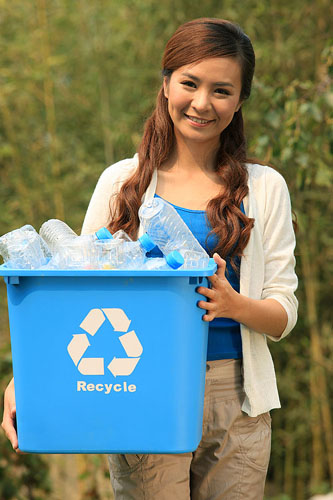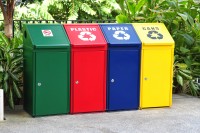Biopolymers are the more eco-friendly material, but farming and energy-intense chemical processing means they are dirtier to produce than petroleum-derived plastics, according to study in Environmental Science & Technology
Contact: Morgan Kelly | mekelly@pitt.edu | 412-624-4356 | Cell: 412-897-1400
PITTSBURGH—An analysis of plant and petroleum-derived plastics by University of Pittsburgh researchers suggests that biopolymers are not necessarily better for the environment than their petroleum-based relatives, according to a report in Environmental Science & Technology. The Pitt team found that while biopolymers are the more eco-friendly material, traditional plastics can be less environmentally taxing to produce.
Biopolymers trumped the other plastics for biodegradability, low toxicity, and use of renewable resources. Nonetheless, the farming and chemical processing needed to produce them can devour energy and dump fertilizers and pesticides into the environment, wrote lead author Michaelangelo Tabone (ENG, A&S ’10), who conducted the analysis as an undergraduate student in the lab of Amy Landis, a professor of civil and environmental engineering in Pitt’s Swanson School of Engineering. Tabone and Landis worked with James Cregg, an undergraduate chemistry student in Pitt’s School of Arts and Sciences; and Eric Beckman, codirector of Pitt’s Mascaro Center for Sustainable Innovation and the George M. Bevier Professor of Chemical and Petroleum Engineering in Pitt’s Swanson School. The project was supported by the National Science Foundation.
The researchers examined 12 plastics—seven petroleum-based polymers, four biopolymers, and one hybrid. The team first performed a life-cycle assessment (LCA) on each polymer’s preproduction stage to gauge the environmental and health effects of the energy, raw materials, and chemicals used to create one ounce of plastic pellets. They then checked each plastic in its finished form against principles of green design, including biodegradability, energy efficiency, wastefulness, and toxicity.
Biopolymers were among the more prolific polluters on the path to production, the LCA revealed. The team attributed this to agricultural fertilizers and pesticides, extensive land use for farming, and the intense chemical processing needed to convert plants into plastic. All four biopolymers were the largest contributors to ozone depletion. The two tested forms of sugar-derived polymer—standard polylactic acid (PLA-G) and the type manufactured by Minnesota-based NatureWorks (PLA-NW), the most common sugar-based plastic in the United States—exhibited the maximum contribution to eutrophication, which occurs when overfertilized bodies of water can no longer support life. One type of the corn-based polyhydroyalkanoate, PHA-G, topped the acidification category. In addition, biopolymers exceeded most of the petroleum-based polymers for ecotoxicity and carcinogen emissions.

Once in use, however, biopolymers bested traditional polymers for ecofriendliness. For example, the sugar-based plastic from NatureWorks jumped from the sixth position under the LCA to become the material most in keeping with the standards of green design. On the other hand, the ubiquitous plastic polypropylene (PP)—widely used in packaging—was the cleanest polymer to produce, but sank to ninth place as a sustainable material.
Interestingly, the researchers found that the petroleum-plant hybrid biopolyethylene terephthalate, or B-PET, combines the ills of agriculture with the structural stubbornness of standard plastic to be harmful to produce (12th) and use (8th).
Landis is continuing the project by subjecting the polymers to a full LCA, which will also examine the materials’ environmental impact throughout their use and eventual disposal.

<table style="cursor: default; margin-top: 1em; margin-right: 0px; margin-bottom: 1em; margin-left: 0px; width: 600px; border: 0px dashed #bbbbbb;" border="0" cellspacing="0" cellpadding="0" align="center">
<tbody>
<tr>
<td style="width: 50px; text-align: center;"><strong>Polymer</strong></td>
<td style="width: 50px; text-align: center;"><strong>Material</strong></td>
<td style="width: 10px; text-align: center;"> <strong>Green Design Rank</strong></td>
<td style="width: 10px; text-align: center;"><strong>LCA Rank</strong></td>
</tr>
<tr>
<td style="width: 50px;">Polylactic acid-NatureWorks (PLA-NW)</td>
<td style="width: 50px;">Sugar, cornstarch</td>
<td style="width: 10px; text-align: center;">1</td>
<td style="width: 10px; text-align: center;">6</td>
</tr>
<tr>
<td style="width: 50px;">Polyhydroxyalkanoate-Stover (PHA-S)</td>
<td style="width: 50px;">Corn stalks</td>
<td style="width: 10px; text-align: center;">2</td>
<td style="width: 10px; text-align: center;">4</td>
</tr>
<tr>
<td style="width: 50px;">Polyhydroxyalkanoate-General (PHA-G)</td>
<td style="width: 50px;">Corn kernels</td>
<td style="width: 10px; text-align: center;">2</td>
<td style="width: 10px; text-align: center;">8</td>
</tr>
<tr>
<td style="width: 50px;">Polylactic acid-General (PLA-G)</td>
<td style="width: 50px;">Sugar, cornstarch</td>
<td style="width: 10px; text-align: center;">4</td>
<td style="width: 10px; text-align: center;">9</td>
</tr>
<tr>
<td style="width: 50px;">High-density polyethylene (HDPE)</td>
<td style="width: 50px;">Petroleum</td>
<td style="width: 10px; text-align: center;">5</td>
<td style="width: 10px; text-align: center;">2</td>
</tr>
<tr>
<td style="width: 50px;">Polyethylene Terephthalate (PET)</td>
<td style="width: 50px;">Petroleum</td>
<td style="width: 10px; text-align: center;">6</td>
<td style="width: 10px; text-align: center;">10</td>
</tr>
<tr>
<td style="width: 50px;">Low-density polyethylene (LDPE)</td>
<td style="width: 50px;">Petroleum</td>
<td style="width: 10px; text-align: center;">7</td>
<td style="width: 10px; text-align: center;">3</td>
</tr>
<tr>
<td style="width: 50px;">Biopolyethylene terephthalate (B-PET)</td>
<td style="width: 50px;">Petroleum, plants</td>
<td style="width: 10px; text-align: center;">8</td>
<td style="width: 10px; text-align: center;">12</td>
</tr>
<tr>
<td style="width: 50px;">Polypropylene (PP)</td>
<td style="width: 50px;">Fossil fuels</td>
<td style="width: 10px; text-align: center;">9</td>
<td style="width: 10px; text-align: center;">1</td>
</tr>
<tr>
<td style="width: 50px;">General purpose polystyrene (GPPS)</td>
<td style="width: 50px;">Petroleum</td>
<td style="width: 10px; text-align: center;">10</td>
<td style="width: 10px; text-align: center;">5</td>
</tr>
<tr>
<td style="width: 50px;">Polyvinyl chloride (PVC)</td>
<td style="width: 50px;">Chlorine, petroleum</td>
<td style="width: 10px; text-align: center;">11</td>
<td style="width: 10px; text-align: center;">7</td>
</tr>
<tr>
<td style="width: 50px;">Polycarbonate (PC)</td>
<td style="width: 50px;">Petroleum</td>
<td style="width: 10px; text-align: center;">12</td>
<td style="width: 10px; text-align: center;">11<span style="color: #494949; font-family: Verdana, sans-serif; font-size: small;"><span style="font-size: 12px;"><span style="color: #000000; font-family: Verdana, Arial, Helvetica, sans-serif; font-size: x-small;"><span style="font-size: 10px;"><br /></span></span></span></span></td>
</tr>
</tbody>
</table>




